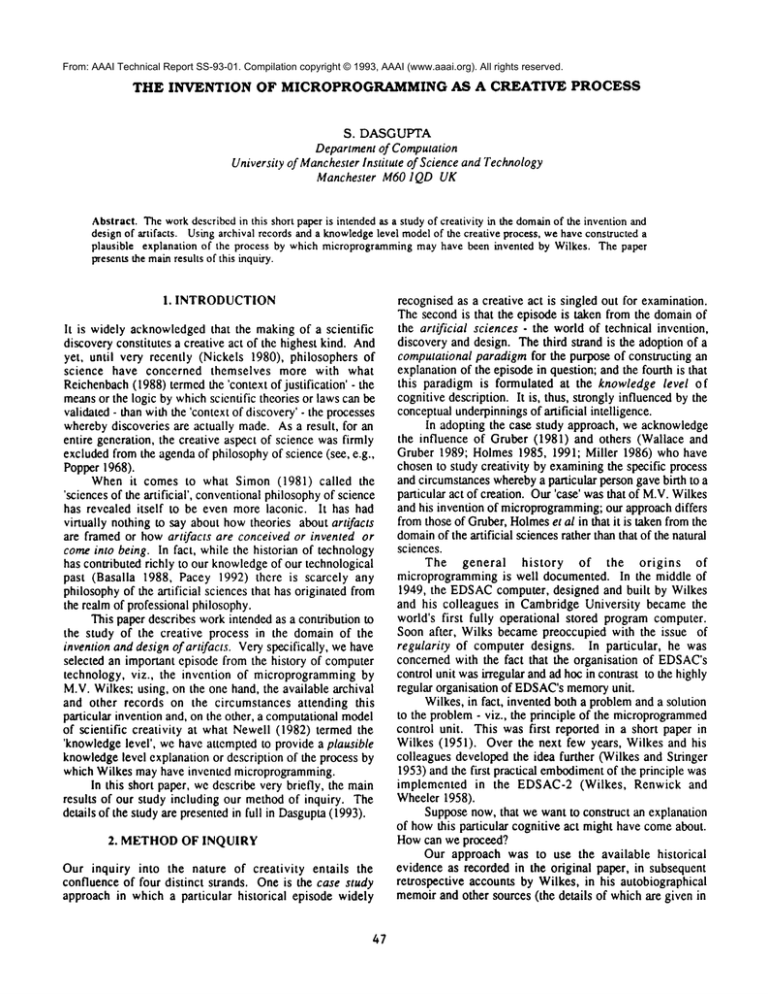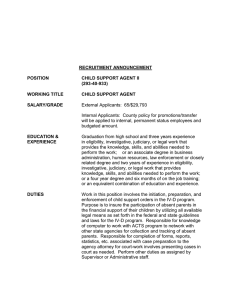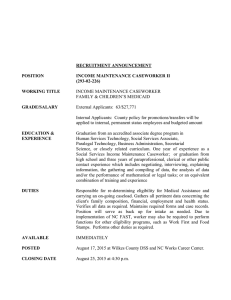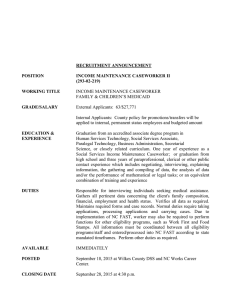
From: AAAI Technical Report SS-93-01. Compilation copyright © 1993, AAAI (www.aaai.org). All rights reserved.
THE INVENTION
OF MICROPROGRAMMING AS A CREATIVE
PROCESS
S. DASGUPTA
Department of Computation
University of ManchesterInstitute of Science and Technology
Manchester M60 1QD UK
Abstract. Theworkdescribedin this short paperis intendedas a study of creativity in the domainof the inventionand
designof artifacts. Usingarchival records and a knowledge
level modelof the creative process, wehaveconstructeda
plausible explanation of the process by which microprogramming
mayhave been invented by Wilkes. The paper
presentsthe mainresults of this inquiry.
1.
INTRODUCTION
It is widely acknowledgedthat the makingof a scientific
discovery constitutes a creative act of the highest kind. And
yet, until very recently (Nickels 1980), philosophers
science have concerned themselves more with what
Reichenbach(i 988) termedthe ’context of justification’ - the
meansor the logic by whichscientific theories or laws can be
validated - than with the ’context of discovery’ - the processes
wherebydiscoveries are actually made. As a result, for an
entire generation, the creative aspect of science was firmly
excluded from the agenda of philosophyof science (see, e.g.,
Popper 1968).
When it comes to what Simon (1981) called the
’sciences of the artificial’, conventionalphilosophyof science
has revealed itself to be even more laconic. It has had
virtually nothing to say about howtheories about artifacts
are framed or how artifacts are conceived or invented or
comeinto being. In fact, while the historian of technology
has contributed richly to our knowledgeof our technological
past (Basalla 1988, Pacey 1992) there is scarcely any
philosophyof the artificial sciences that has originated from
the realm of professional philosophy.
This paper describes work intended as a contribution to
the study of the creative process in the domain of the
invention and design of artifacts. Veryspecifically, we have
selected an important episode from the history of computer
technology, viz., the invention of microprogrammingby
M.V.Wilkes; using, on the one hand, the available archival
and other records on the circumstances attending this
particular invention and, on the other, a computationalmodel
of scientific creativity at what Newell (1982) termed the
’knowledgelevel’, we have attempted to provide a plausible
knowledgelevel explanation or description of the process by
which Wilkes may have invented microprogramming.
in this short paper, we describe very briefly, the main
results of our study including our methodof inquiry. The
details of the study are presented in full in Dasgupta(1993).
2.
METHODOF INQUIRY
Our inquiry into the nature of creativity entails the
confluence of four distinct strands. One is the case study
approach in which a particular historical episode widely
47
recognised as a creative act is singled out for examination.
The second is that the episode is taken from the domainof
the artificial sciences - the world of technical invention,
discovery and design. The third strand is the adoption of a
computational paradigmfor the purpose of constructing an
explanation of the episode in question; and the fourth is that
this paradigm is formulated at the knowledge level of
cognitive description. It is, thus, strongly influenced by the
conceptualunderpinningsof artificial intelligence.
In adopting the case study approach, we acknowledge
the influence of Gruber (1981) and others (Wallace
Gruber 1989; Holmes 1985, 1991; Miller 1986) who have
chosen to study creativity by examiningthe specific process
and circumstances wherebya particularperson gave birth to a
particular act of creation. Our ’case’ was that of M.V.Wilkes
and his invention of microprogramming;
our approach differs
fromthose of Gruber, Holmeset al in that it is taken fromthe
domainof the artificial sciences rather than that of the natural
sciences.
The general
history
of the origins
of
microprogramming is well documented. In the middle of
1949, the EDSAC
computer, designed and built by Wilkes
and his colleagues in Cambridge University became the
world’s first fully operational stored program computer.
Soon after, Wilks became preoccupied with the issue of
regularity of computer designs. In particular, he was
concerned with the fact that the organisation of EDSAC’s
control unit was irregular and ad hoc in contrast to the highly
regular organisation of EDSAC’s
memoryunit.
Wilkes, in fact, invented both a problemand a solution
to the problem- viz., the principle of the microprogrammed
control unit. This was first reported in a short paper in
Wilkes (1951). Over the next few years, Wilkes and his
colleagues developed the idea further (Wilkes and Stringer
1953) and the first practical embodiment
of the principle was
implemented in the EDSAC-2 (Wilkes, Renwick and
Wheeler 1958).
Supposenow, that we want to construct an explanation
of howthis particular cognitive act might have comeabout.
Howcan we proceed?
Our approach was to use the available historical
evidence as recorded in the original paper, in subsequent
retrospective accounts by Wilkes, in his autobiographical
memoirand other sources (the details of which are given in
Dasgupta(1993)) as the basis for a plausible account of
Wilkesmight have been led to his invention.
Anysuch explanation requires to be framed within a
paradigm (Kuhn 1962). Our paradigm - our explanatory
framework- is a knowledge level computational theory of
creativity which is believed to be applicable to the natural
and the artificial sciences. Accordingto this theory, any
process conducted by a cognitive agent resulting in the
production of an original - in some well defined sense
(Dasgupta1993) - entity (a theory, law, artifactual form
design, principles, etc.) can be described solely in terms of
(a) symbolic structures that represent goals, solutions and
knowledge;(b) actions that transform one symbolic structure
to another such that (c) each such transformation is solely
function of the facts, rules and laws contained in the agent’s
knowledge body and of the goals to be achieved at that
particular time. This theory as a hypothesis about the nature
of the creative process, has its origins in Newell, Shawand
Simon’s(1962) classic paper on creativity and its relationship
to computation.
Thus, given this knowledge level theory and the
documentaryrecords of the historical episode itself, we have
constructed an explanation of how Wilkes might have
invented the technique of microprogramming.
3.
A SUMMARYOF THE EXPLANATORYPROCESS
This explanation takes the form of a knowledge level
computational process which begins with an empirical fact
(as observed in the EDSACand other computers under
development circa 1950):
FO:
Extant control units are difficult to maintain,
repair and design because of their complexity
and ends with the familiar dual diode-matrix form for the
microprogrammed
control unit which Wilkes had proposed in
his 1951 paper. The process itself consists of a sequence of
several subprocesses:
(a) Problem recognition and formulation: The result of
this subprocessis a goal:
GI:
Design a control unit that has a simple,
regular and repetitive structure.
(b) Arriving at the idea of using a diode matrix: This
subprocess begins with goal GI and produces as an
output, the goal
Design a control unit to be implemented
G2:
in terms of a diode matrix.
such that if G2is achieved then so will be GI. That is,
G2is a subgoalof G 1.
(c) Identification of a stored programcomputer-like form:
This has, as input, an initial postulated goal
The control unit must be functionally
G3:
flexible.
and produces as output the subgoal of G3:
G4:
Specify the control unit in a stored
program computer-like form.
(d) Deriving the broad principal of microprogramming:
This process begins with G2and G4 and results in the
subgoals:
G5:
The task to be performedby the control
until will be specified by a (micro)
48
programconsisting of a set of (micro)
orders each held at a distinct addressin a
memory.
On completion of a (micro) order’s
G6:
execution, the task of identifying the
’next’ microorderto ’normally’execute is
specified by a ’next’ (micro)order
address mechanism.
(e) Relating the microprogram and diode matrix ideas:
This process begins with goals G2, G5 and G6 and
results in the subgoals:
G7:
The microprogram[consisting of a set of
microorders each at a specified address
in a memory]is to be implemented in
terms of a diode matrix.
G8:
The next microorder address mechanism
[for the sequencingof microorders]is to
be implemented in terms of a diode
matrix.
(f) Realising a diode matrix representation of the
microprogram : This phase begins with G7 and
produces a network of subgoals culminating in a diode
matrix implementation of G7.
(g) Realising a diode matrix representation for next
microorder addresses: This subprocess begins with
G8 and generates a network of subgoals leading,
eventually, to a diode matrix realisation of G8.
(h) Coupling the diode matrices: This subprocess takes as
input the diode matrix forms previously generated
along with the original pair of goals G2 and G4,
determines that the ’current’ design does not fully
satisfy G4, and generates a series of subgoals which
culminates in the coupling of the two diode matrices.
(i) Solving the problemof alternative successor addresses:
The ’new’ design is again compared to G4 and,
determining that G4has yet to be completelysatisfied,
this subprocess produces a further series of subgoals
which results, finally, in the dual diode matrix form
that was actually proposed by Wilkes.
The entire process is driven by a range of knowledge
tokens (facts and rules) that were either postulated to
contained in Wilkes’s knowledgebody or were inferred in the
course of the process. These tokens can be hierarchically
organised into several categories according to their scope.
Specifically, these categories of knowledgeconcern:
(1) The world at large
(2) Entities in general
(3) Artifacts (a kind of entity)
(4) Hardwarecircuits/devices (a kind of artifact)
(5) Diode matrices (a kind of hardware device)
(6) Computers(also a kind of hardware device)
(7) Stored programcomputers (a kind of computer)
(8) The Cambridge EDSAC(an instance of a stored
program computer)
(9) The MITWhirlwind (an instance of a stored program
computer)
(10) Control units (a component of the stored program
computer)
(11) Conventionalcontrol units (a kind of control unit)
(12) Microprogrammed
control unit (also a kind of control
uniO
Of particular interest is the first category of knowledge
tokens. These include various inference rules allowing for
inferences by instantiation, generalisation, abduction and
deduction and a few, very general heuristics such as meansends analysis (Newell and Simon 1972). These inference
rules enable subgoals to be generated as consequences from
given goals (whichserve as antecedents) as well as additional
facts and rules.
4.
EIGHT HYPOTHESES CONCERNING
INVENTING AND CREATIVITY
Wemay summarise the insight gained from this study in
terms of a number of hypotheses about the nature of
creativity.
(HI)
(H2)
(H3)
(H4)
(H5)
(H6)
(H7)
Inventing - that is creating an artifactual form- is a
goal-directed or purposive endeavour. In this
respect, it appears to be no different from more
ordinary kinds of design processes.
Creative acts, at least in the realm of invention and
discovery, are highly opportunistic in nature: they
rely on the generation of goals or subgoalsthat serve
as working hypotheses.
Large insights are composed of a specifiable
network of small steps; acts of creation are
gradualistic in nature.
Acts of combiningseemingly unrelated ideas (which
appear to be inherent to the creative process)
termed ’bisociation’
by Koestler (1964) - are
explainable in terms of commonplace rules of
inference.
Creative acts are reasoning processes involving
rules of inference and general heuristics.
Creative processes, at least in the realmof invention
and discovery, are knowledgeintensive.
The creative agent is one who has the ability to
wander freely and associatively
about the
knowledgespace and retrieve whatever tokens seem
relevant to the goals at that level.
Each of these propositions are consistent with one or
another of the conclusions about the nature Of creativity
reached by Perkins (1981), Gruber (1981), Holmes(1985,
1991) and Weisberg(1989). The difference lies in our use
the knowledgelevel computation paradigmwhich, because it
enables an explanation to be constructed in the form of a
knowledge level process , allows for a much sharper
interpretation of these hypotheses.
Our final hypothesis is arrived at by noting that (HI)(H7) above are also consistent with the observed
hypothesized nature of discovery processes in the natural
sciences (Kulkarni and Simon 1988; Langley et al 1987;
Thagard1988, 1990). This suggests a fundamentalsimilarity
between invention (the supreme act of creation in the
artificial sciences) and discovery(the supremeact of creation
in the natural sciences). Wethus propose the hypothesis
(H8)
The process of inventing artifactual forms in the
artificial sciences is cognitively indistinguishable at
the knowledgelevel from the process of inventing
theories or discovering laws in the natural sciences.
49
REFERENCES
Basalla, G. (1988), The Evolution of Technology, Cambridge
UniversityPress, Cambridge,U.K.
Dasgupta, S., (1993), Creativity in Invention and Design,
Cambridge
UniversityPress, Cambridge,
U.K.(in press).
Gruber, H.E. (1981), Darwinon Man:A Psychological Study oJ
Scientific Creativity, Univ. of ChicagoPress, Chicago,IL.
(2ndEd.).
Holmes, F.L. (1985), Lavoisier and the Chemistry of Life,
Universityof Wisconsin
Press, Madison,WI.
Holmes,F.L. (1991) HansKrebs: The Formationof a Scientific
Life, 1900.1937,Vol. 1, OxfordUniversityPress, NewYork.
Koestler, A. (1964) The Act of Creation, Hutchinson& Co.,
London.
Kuhn,T.S. (1962), TheStructureof Scientifc Revolutions,Univ.of
ChicagoPress, Chicago,IL.
Kulkami,D. and Simon,H.A.(1988), "TheProcessesof Scientific
Discovery: The Strategy of Experimentation", Cognitive
Science, 12, 139-176.
Langley,P., Simon,H.A., Bradshaw,G.L. and Zytkow,J.M. (1987)
Scientific Discovery,MITPress, Cambridge,M.A.
Miller, A.I. (1986), Imageryin Scientific Thought,MITPress,
Cambridge,M.A.
Newell,A. (1982), "the Knowledge
Level", Artificial Intelligence,
18, 87-137.
Newell, A. and Simon, H.A. (1972), HumanProblem Solving,
Prentice-Hall,Englewood-Cliffs,
N.J.
Newell,A., Shaw,J.C., and Simon,H.A.(1962), ’’TheProcesses
Creative Thinking", in H.E. Gruber, G. Terrell and M.
Wertheimer(Eds.); ContemporaryApproachesto Creative
Thinking,AthertonPress, NewYork,63-119.
Nickels,T. (1980)"Introductory
Essay:Scientific Discoveryandthe
Future of Philosophy of Science", in T. Nickels (Ed),
Scientific Discovery,LogicandRationality,D. Reidel, Boston,
MA.,1-60.
Pacey, A. (1992) The Mazeof Ingenuity, MITPress, Cambridge,
MA.
Perkins, D.N. (1981) The Mind’sBest Work,HarvardUniv. Press,
Cambridge,MA.
Popper,K.R.(1968) TheLogicof Scientific Discovery,Harperand
Row,NewYork(originally publishedin German,1934).
Reichenbach, H. (1938) Experience and Prediction, Univ. of
ChicagoPress, Chicago,IL.
Simon, H.A., (1981), Sciences of the Artificial, MITPress,
Cambridge,MA(2nd Ed.).
Thagard, P. (1988), ComputationalPhilosophyof Science, MIT
Press, Cambridge,MA.
Thagard, P. (1990), "The ConceptualStructure of the Chemical
Revolution",Phil. of Science,57, 183-209.
Wallace,D.B.and Gruber,H.E. (Eds.) (1989), Creative Peopleat
Work,OxfordUniversityPress.
Weisberg,R.W.(1986) Creativity: Geniusand other Myths, W.H.
Freemanand Co., NewYork.
Wilkes, M.V. (1951) "The Best Wayto Design an Automatic
Calculating Machine", Rept. ManchesterUniv. Computer
lnaug. Conf., Manchester,
U.K.July.
Wilkes, M.V., and Stringer, J.B. (1953), "Microprogramming
and
the Designof the ControlCircuits in an Electronic Digital
Computer",
Proc.Camb.Phil. Soc., Pt. 2, 49, April, 230-238.
Wilkes,M.V.,Renwick,W.and Wheeler,D.J. (1958), ’’The Design
of a ControlUnit of an Electronic Digital Computer",Proc.
IEE(U.K.),105, BI21.




